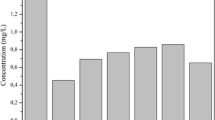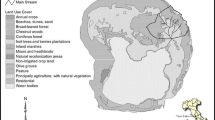Abstract
Improved understanding of temporal and spatial Phosphorus (P) discharge variations is needed for improved modelling and prioritisation of abatement strategies that take into account local conditions . This study is aimed at developing modelling of agricultural Phosphorus losses with improved spatial and temporal resolution, and to compare the accuracy of a detailed process-based model with a rainfall-runoff coefficient-based model. The process-based SWAT model (Soil and Water Assessment Tool) was implemented for five river basins in central Sweden, and results compared with the rainfall-runoff coefficient-based model WATSHMAN (Watershed Management System) for one of these river basins. Parameter settings and attribute values were adapted to Scandinavian soil conditions, crops and management practices. Model performance regarding flow dynamics was overall satisfactory. Comparable results were achieved at several scales. The modelled P load was of high accuracy for the days when monitoring data were available for validation, generally once a month. Modelled monthly P load did not fit as well with averaged monthly monitoring load values, mainly since monthly monitoring often partly or entirely misses the peak flows. The comparison of SWAT and WATSHMAN gave slightly better results for the process-based model (SWAT). Better spatial resolution for input data such as Soil-P content and agricultural management practices will be required to reach modelling results that enable identification of measures adapted to local conditions.











Similar content being viewed by others
References
Abbaspour, K.C. 2009. SWAT-CUP2 SWAT Calibration and Uncertainty Programs. Version2. http://www.eawag.ch/organisation/abteilungen/siam/software/swat/downloads/Manual_SwatCup.pdf. Accessed 28 Apr 2009.
Abbaspour, K.C., C.A. Johnson, and M.Th. van Genuchten. 2004. Estimating uncertain flow and transport parameters using a sequential uncertainty fitting procedure. Vadose Zone Journal 3: 1340–1352.
Alavi, G. 1999. Climate, leaf area, soil moisture and tree growth in spruce stands in SW Sweden: Field experiments and modelling. Doctoral thesis, Swedish University of Agricultural Sciences, Agraria, 175 pp.
Alström, K., and A. Bergman. 1990. Water erosion on arable land in southern Sweden. In Soil erosion on agricultural land, ed. J. Boardman, I.D.L. Foster, and J.A. Dearing, 107–117. Chichester: Wiley.
Andersson, L., J. Rosberg, C. Pers, J. Olsson, and B. Arheimer. 2005. Estimating catchment nutrient flow with the HBV-NP model: Sensitivity to input data. Ambio 34: 521–532.
Bicknell, B., J. Imhoff, J. Kittle, T. Jobes, and A. Donigian. 2001. BASINS HSPF users manual. Reston, VA: Office of Information, Water Resources Discipline, US Geological Survey. http://www.epa.gov/waterscience/basins/bsnsdocs.html, 843 pp.
Blombäck, K. 1998. Carbon and Nitrogen in Catch Crop Systems: Modelling of seasonal and long-term dynamics in plant and soil. Doctoral thesis, Swedish University of Agricultural Sciences, Agraria, 134 pp.
Brandt, M., and H. Ehjed. 2002. Transport–Retention–Source Apportionment. Swedish Environmental Protection Agency report 5247 (in Swedish).
Chow, V.T., D.R. Maidment, and L.W. Mays. 1988. Applied hydrology. New York: McGraw-Hill Inc.
Dahl, M., and C. Pers. 2004. Comparison of four models for simulation of phosphorus dynamics in Lake Vänern, Sweden. Hydrology and Earth System Sciences 8: 1153–1163.
Djodjic, F., and L. Bergström. 2005a. Phosphorus losses from arable fields in Sweden—effects of field-specific factors and long-term trends. Environmental Monitoring and Assessment 102: 103–117.
Djodjic, F., and L. Bergström. 2005b. Conditional Phosphorus Index as an educational tool for risk assessment and phosphorus management. Ambio 34: 296–300.
Djodjic, F., K. Börling, and L. Bergström. 2004. Phosphorus leaching in relation to soil type and soil phosphorus content. Journal of Environmental Quality 33: 678–684.
EEA. 2001. Eutrophication in Europe’s coastal waters, Topic Report No 7, 86. Copenhagen, Denmark: European Environment Agency.
Ekstrand, S. 2001. WATSHMAN, Watershed Management System: Modelling nutrient transport in river basins. IVL-report, IVL Swedish Environmental Research Institute (www.ivl.se), 22 pp.
Eriksson, J., Andersson, A., and Andersson, R. 1997. Current status of Swedish arable soils. Swedish Environmental Protection Agency, Report 4778.
Gentry, L.E., M.B. David, T.V. Royer, C.A. Mitchell, and K.M. Starks. 2007. Phosphorus transport pathways to streams in tile-drained agricultural watersheds. Journal of Environment Quality 36: 408–415.
HELCOM. 2004. The Fourth Baltic Sea Pollution Load Compilation. HELCOM—Helsinki Commission, Governing body for 1992 convention signed by all the countries bordering on the Baltic Sea and by the European Economic Community, 130 pp.
Hill, A.R. 1981. Stream phosphorus exports from watersheds with contrasting land uses in Southern Ontario. Water Resources Bulletin 17: 627–634.
Johansson, J.-Å., and H. Kvarnäs. 1998. Modelling of nutrients in Storsjön and its catchment Report for the County Board of Gävleborg. Report 1998: 13 (in Swedish).
Johnsson, H., and K. Mårtensson. 2002. Nitrogen losses from Swedish arable land—calculation av normal leaching for 1995–1999. Swedish Environmental Protection Agency Report 5248 (in Swedish).
Johnsson, H., M. Larsson, A. Lindsjö, K. Mårtensson, K. Persson, and G. Torstensson. 2008. Leakage of nutrients from Swedish farmland. Report 5823, 106–152. Swedish Environmental Protection Agency (in Swedish).
Jordan, T.E., D.F. Whigham, K.H. Hofmockel, and M.A. Pittek. 2003. Nutrient and sediment removal by a restored wetland receiving agricultural runoff. Journal of Environment Quality 32: 1534–1547.
Kirchmann, H. 1991. Properties and classification of soils of the Swedish long-term fertility experiment—I. Sites at Fors and Kungsängen. Acta Agriculturae Scandinavica 41: 227–242.
Kirchmann, H., J. Eriksson, and S. Snäll. 1999. Properties and classification of soils of the Swedish long-term fertility experiments—I. Sites at Ekebo and Fjärdingslöv. Acta Agriculturae Scandinavica: Section B, Soil & Plant Science 49: 25–38.
Kronvang, B., L.M. Svendsen, J.P. Jensen, and J. Dörge. 1999. Scenario analysis of nutrient management at the river basin scale. Hydrobiologia 410: 207–212.
Krysanova, V., F. Hattermann, and F. Wechsung. 2005. Development of the ecohydrological model SWIM for regional impact studies and vulnerability assessment. Hydrological Processes 19: 763–783.
Lind, B.B., and L. Lundin. 1990. Saturated hydraulic conductivity of Scandinavian Tills. Nordic Hydrology 21: 107–118.
McDowell, R.W., and R.M. Monaghan. 2002. The potential for phosphorus loss in relation to nitrogen fertilizer application and cultivation. New Zealand Journal of Agricultural Sciences 45: 245–253.
McKay, M.D. 1988. Sensitivity and uncertainty using a statistical sample of input values. In Uncertainty analysis, ed. Y. Ronen, 145–186. Boca Raton, FL: CRC Press Inc.
Meyer, J.L., and G.E. Likens. 1979. Transport and transformations of Phosphorus in a forest stream ecosystem. Ecology 60: 1255–1269.
Neitsch, S.L., J.C. Arnold, J.R. Kiniry, J.R. Williams, and K.W. King. 2002. Soil and Water Assessment Tool Theoretical Documentation. Version 2000. College Station, Texas: Texas Water Resources Institute.
Pers, B.C. 2002. Model description of BIOLA: A biogeochemical lake model. SMHI reports RH no. 17, 69. Norrköping, Sweden: Swedish Meteorological and Hydrological Institute.
Persson, K. 2001. Measurement and modeling of phosphorus transport from arable land Ekohydrologi Report 58. Uppsala: Swedish University of Agricultural Sciences.
Petersen, C.T., S. Hansen, and H.E. Jensen. 1997. Tillage-induced horizontal periodicity of preferential flow in the root zone. Soil Science Society of America Journal 61: 586–594.
Pionke, H.B., W.J. Gburek, A.N. Sharpley, and J.A. Zollweg. 1997. Hydrologic and chemical controls of phosphorus loss from catchments. In Phosphorus loss to water from agriculture, ed. H. Tunney, O.T. Carton, P.C. Brookes, and A.E. Johnston, 225–242. Cambridge: CAB International Press.
Ron Vaz, M.D., A.C. Edwards, C.A. Shand, and M.S. Cresser. 1993. Phosphorus fractions in soil solution: Influence of soil acidity and fertilizer additions. Plant and Soil 148: 175–183.
SCB (Statistics Sweden). 1997. Jordbruksstatistisk årsbok (Annual agricultural statistics), 244. Stockholm: Statistiska Centralbyrån (in Swedish).
Sharpley, A.N., S.C. Chapra, R. Wedepohl, J.T. Sims, T.C. Daniel, and K.R. Reddy. 1994. Managing agricultural phosphorus for protection of surface waters: Issues and options. Journal of Environmental Quality 23: 437–451.
Stålnacke, P., A. Grimvall, C. Libiseller, M. Laznik, and I. Kokorite. 2003. Trends in nutrient concentrations in Latvian river and the response to the dramatic change in agriculture. Journal of Hydrology 283: 184–205.
Tarafdar, J.C., and N. Classen. 1988. Organic phosphorus compounds as a phosphorus source for higher plants through the activity of phosphatase produced by plant roots and microorganisms. Biology and Fertility of Soils 5: 308–312.
Tonderski, K., B. Arheimer, and C. Pers. 2005. Modelling the impact of potential wetlands on phosphorus retention in a Swedish catchment. Ambio 34: 544–551.
Ulén, B. 1997. Phosphorus losses from arable land. Swedish Environmental Protection Agency report 4731 (in Swedish).
Ulén, B., Johansson, G., and Kyllmar, K. 2000. Phosphorus leaching from eleven observation fields during 21 years, 15–22. Ekohydrologi Report 52, Swedish University of Agricultural Sciences (in Swedish).
Vandenberghe, V., A. van Grienseven, and W. Bauwens. 2001. Sensitivity analysis and calibration of the parameters of ESWAT: Application to the river Dender. Water Science and Technology 43(7): 295–301.
Wiklert, P., S. Andersson, and B. Weidow. 1983. Studies of soil profiles in Swedish agricultural soils—a data synthesis. Department of soil sciences, Swedish university of agricultural sciences (in Swedish).
Wild, A., and O.L. Oke. 1966. Organic phosphate compounds in calcium chloride extracts of soils: Identification and availability to plants. Journal of Soil Science 17: 356–371.
Williams, J.R., C.A. Jones, and P.T. Dyke. 1984. A modelling approach to determining the relationship between erosion and soil productivity. Transactions of the ASAE 27: 129–144.
Zakrisson, J., S. Ekstrand, and M. Olshammar. 2003. Phosphorus and Nitrogen modelling for catchments relating to the EU Water framework directive. IVL-report B-2003 report nr 1550 (in Swedish) www.ivl.se, 61 pp.
Author information
Authors and Affiliations
Corresponding author
Rights and permissions
About this article
Cite this article
Ekstrand, S., Wallenberg, P. & Djodjic, F. Process Based Modelling of Phosphorus Losses from Arable Land. AMBIO 39, 100–115 (2010). https://doi.org/10.1007/s13280-010-0016-5
Published:
Issue Date:
DOI: https://doi.org/10.1007/s13280-010-0016-5




